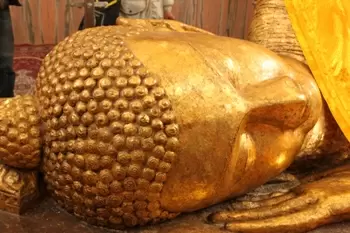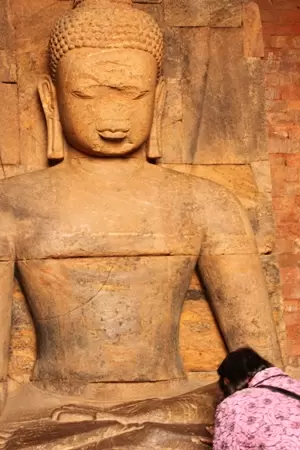On a train, in Buddha’s footsteps

09-February-2013
Vol 4 | Issue 6
It's a trip down the Buddha's lane, into antiquity and serenity. Tracking the Buddha's path, the Mahaparinirvana Express is for the historian, the tourist, and of course, the pilgrim seeking salvation in retracing the footsteps of the man who walked this land some 2,400 years ago.
The special train dedicated to Buddhist pilgrims does the circuit twice every month in the cooler months of the year - beginning from New Delhi and taking the traveller to places like Varanasi and Gorakhpur in Uttar Pradesh before getting into Gaya in Bihar.
 |
|
The statue at Kushinagar, representing the Buddha in Mahaparinirvana (Photos: IANS)
|
Sarnath, where the Buddha gave his first sermon, is just 13 km from Varanasi. From Gorakhpur, travellers are taken to Kushinagar, where he died and attained mahaparinirvana (death, and ascent to "deathlessness"), and Lumbini, where he was born. And Gaya is where he attained enlightenment.
The train, which has been running for six years, takes a week to complete the tour. It is named after the Mahaparinirvana Sutra, the Buddha's sayings in days preceding his death. (The association with death makes some people think Indian Railways should change the train's name!)
It's a train ride to history for some, spirituality for others.
At Sarnath, a solitary man sat chanting in a nook among the ruins. Other visitors peeped into bottomless wells, and wandered looking at the ruins of monasteries and what remains of Emperor Ashoka's famous Sarnath pillar, the capital of which is the four-lion emblem of modern India.
The lone pilgrim sat hidden from sight by what, over 2,000 years ago, was the corner of a room. These days, the brick walls are just high enough to shield a man squatting on the ground from intrusive, photograph-seeking tourists.
A group of Thai pilgrims on the Mahaparinirvana ride sat cross-legged at the Mulagangha Kuti, the site in Sarnath where the Buddha is believed to have sat in meditation.
Only 200 years after he died, when Emperor Ashoka had converted to Buddhism, did many of these spots become sites for monasteries.
From Gorakhpur, the travellers take the bus to Kushinagar, about 50 km away, where the Buddha died after a brief spell of diarrhoea.
He is believed to have had a premonition of death, and travelled to this spot on the banks of the Hiranyavati river to make it convenient for followers to converge for his last rites.
At Kushinagar, an over six-metre terracotta statue of the Buddha lying on his side tells of a peaceful death. The Buddha died when he was nearly 80, but not a wrinkle mark is on the face of the statue, which has since been painted golden. (The red of the terracotta peeps through from the base.)
The Mahaparinirvana pilgrims then ride a bus nearly 160 km from Kushinagar into Lumbini, across the border with Nepal, where the Buddha was born. A large stone sculpture here shows baby Buddha emerging from his mother's side. (Yes, side. That was where he was believed to have emerged from.)
Last month, the train for the first time made a trial run into Odisha, where there are ruins of ancient Buddhist monasteries, all constructed between 3rd and 5th century AD, at Udaigiri, Ratnagiri and Lalitgiri.
The cells of the monks are typically arranged around a central courtyard, and resting against the wall across the main entrance is a large, imposing statue of the Buddha. There are clear signs of vandalism on the statues -- one large Buddha figure has the nose hewn out roughly, and sharp edges mark the hollow where the nose was.
Alexandar Cunnnigham, known as the father of the Archeological Survey of India, was renowned for excavating Buddhist sites in India in the mid-19th century. The Mahabodhi Temple in Gaya, about 95 km from Patna, Bihar's capital, was among the important sites that Cunningham unearthed.
This temple marks the site where the Buddha gained nirvana or enlightenment.
 |
|
Statue at the centre of a monastery in Ratnagiri, Odhisa. The nose appears to have been roughly hewn out of the stone by vandals
|
There are many reasons to take the Mahaparinirvana ride. It's not just about religion - there are 350 million Buddhists in the world - it's also about delving into the ancient past.
And one's orientation would colour what one sees. "What tourists on this circuit see are only ruins of great antiquity. For those who have not witnessed it, it's hard to imagine the awe and devotion that pilgrims feel when they see these ruins," said Joginder Gujjar of the Indian Railway Catering and Tourism Corporation (IRCTC).
The Mahanirvana Express begins from New Delhi's Safdarjung station and ends there. Travel on the air-conditioned train ranges from $700 per head to $1,120, including meals and the cost of travel to the various destinations.
(Rosamma Thomas travelled on the Mahaparinirvana Express Jan 20-27 on an invitation from IRCTC and the Odisha Tourism Department.) - IANS














